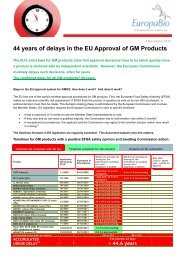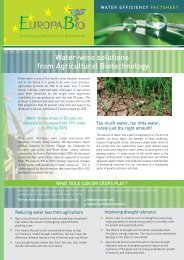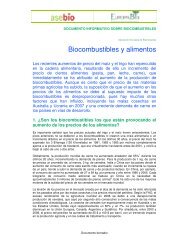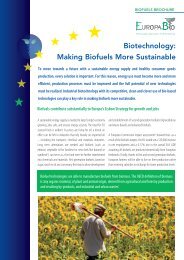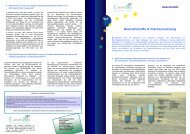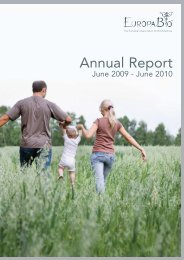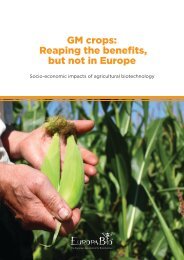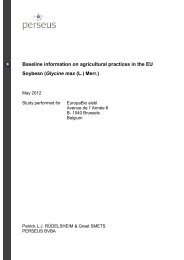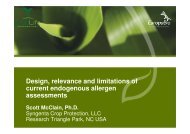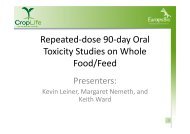Baseline information on agricultural practices in the EU ... - Europabio
Baseline information on agricultural practices in the EU ... - Europabio
Baseline information on agricultural practices in the EU ... - Europabio
Create successful ePaper yourself
Turn your PDF publications into a flip-book with our unique Google optimized e-Paper software.
4 Preparati<strong>on</strong><br />
4.1 Seeds<br />
Breed<strong>in</strong>g beets for sugar producti<strong>on</strong> has taken place s<strong>in</strong>ce <strong>the</strong> late 18 th century. By <strong>the</strong> beg<strong>in</strong>n<strong>in</strong>g of<br />
<strong>the</strong> 19 th century beets had a sugar c<strong>on</strong>tent of about 6%. Selecti<strong>on</strong>s probably orig<strong>in</strong>ated from fodder<br />
beets grown <strong>in</strong> Poland from a type known as White Silesian.<br />
The goal of breed<strong>in</strong>g programmes is to develop sugar beet varieties with higher root yield and higher<br />
sugar c<strong>on</strong>tent, better extracti<strong>on</strong> yield (juice purity), higher and more uniform seed emergence<br />
percentages, seedl<strong>in</strong>g vigour, lower tendency to “bolt”. Also important are <strong>the</strong> physical attributes of <strong>the</strong><br />
root well adapted to mechanical harvest<strong>in</strong>g. The root shape and a smoo<strong>the</strong>r surface resulted <strong>in</strong> a<br />
reducti<strong>on</strong> of soil adherence (less soil tare). Varieties are needed with better resistance to pests and<br />
diseases (especially virus yellows, mildew, rhizomania, rhizoct<strong>on</strong>ia and beet cyst nematodes), better<br />
storability <strong>in</strong>clud<strong>in</strong>g tolerance to frost for <strong>in</strong>-field storage, and <strong>the</strong> ability to perform well over <strong>the</strong> wide<br />
range of envir<strong>on</strong>ments and harvest times. Today, rhizomania tolerant varieties have been developed<br />
for all countries affected by this disease.<br />
In more recent years characteristics such as drought tolerance (better water use efficiency), nitrogen<br />
use efficiency, or stress tolerance <strong>in</strong> general are becom<strong>in</strong>g important as well. A number of drier than<br />
average years s<strong>in</strong>ce 2003 has resulted <strong>in</strong> losses of beet yields <strong>on</strong> soils where <strong>the</strong> crop has been<br />
subject to drought stress.<br />
European legislati<strong>on</strong> requires that every variety undergoes official trials for DUS (Dist<strong>in</strong>ctness,<br />
Uniformity, Stability) and VCU (Value for Cultivati<strong>on</strong> and Use) before commercialisati<strong>on</strong>. The<br />
guidel<strong>in</strong>es for <strong>the</strong> VCU and DUS tests are summarised <strong>in</strong> Directive 2002/53/EC 3 . For sugar beet <strong>the</strong><br />
protocol for dist<strong>in</strong>ctness, uniformity and stability tests of <strong>the</strong> Adm<strong>in</strong>istrative Council of <strong>the</strong> Community<br />
Plant Variety Office (CPVO) is <strong>the</strong> CPVO-TP SUGARBEET/1 4 . This protocol, however, is applicable<br />
to sugar beet comp<strong>on</strong>ents, not to commercial hybrids.<br />
The comm<strong>on</strong> catalogue is based <strong>on</strong> <strong>the</strong> nati<strong>on</strong>al lists of <strong>the</strong> Member States. All Member States<br />
compile <strong>on</strong>e or more nati<strong>on</strong>al catalogues of <strong>the</strong> varieties accepted for certificati<strong>on</strong> and market<strong>in</strong>g <strong>in</strong><br />
<strong>the</strong>ir territory. The implementati<strong>on</strong> of VCU test<strong>in</strong>g by <strong>the</strong> Member States might be different result<strong>in</strong>g <strong>in</strong><br />
different admissi<strong>on</strong> levels between countries. Differences exist <strong>in</strong> <strong>the</strong> preparati<strong>on</strong> of <strong>the</strong> seed, trial layout/field<br />
protocol, evaluated (quality) characteristics, methods of analysis, etc.<br />
New applicati<strong>on</strong>s are tested aga<strong>in</strong>st exist<strong>in</strong>g reference varieties, which will give a clear estimati<strong>on</strong> of<br />
ga<strong>in</strong> of selecti<strong>on</strong> over years. These ‘reference’ varieties will be replaced over time to adapt <strong>the</strong> level of<br />
performance to <strong>the</strong> new developed varieties.<br />
Apart from <strong>the</strong> essential criteria for beet variety recommendati<strong>on</strong>, such as root yield and sugar<br />
c<strong>on</strong>tent, o<strong>the</strong>r criteria such as early or late matur<strong>in</strong>g, resistance/tolerance to specific pests and/or<br />
diseases, nutrient c<strong>on</strong>versi<strong>on</strong> efficiency and <strong>in</strong>ternal quality are also evaluated (CIBE-CEFS, 2010).<br />
Usually 3 years of test<strong>in</strong>g are needed <strong>on</strong> several locati<strong>on</strong>s represent<strong>in</strong>g <strong>the</strong> ma<strong>in</strong> sugar beet grow<strong>in</strong>g<br />
areas.<br />
It is also possible to test for organic sugar beet varieties <strong>in</strong> some Member States (e.g. Belgium,<br />
KBIVB).<br />
Most sugar beet varieties today are diploid hybrids with 2n = 18 chromosomes, derived from a cross<br />
between diploid male sterile female plants and diploid poll<strong>in</strong>ators.<br />
Hybrids are made us<strong>in</strong>g a system of cytoplasmic male sterility (CMS). In this system, normal pollen<br />
development is disrupted by an unknown mechanism associated with a defect <strong>in</strong> <strong>the</strong> mitoch<strong>on</strong>dria.<br />
Mitoch<strong>on</strong>dria are <strong>in</strong>herited maternally; and <strong>the</strong>refore, <strong>on</strong>ly <strong>the</strong> seed parent will c<strong>on</strong>ta<strong>in</strong> a sterile<br />
3<br />
Council Directive 2002/53/EC of 13 June 2002 <strong>on</strong> <strong>the</strong> comm<strong>on</strong> catalogue of varieties of <strong>agricultural</strong><br />
plant species. OJ L 193, 20.7.2002, p.1-15.<br />
4<br />
http://www.cpvo.europa.eu/documents/TP/agricoles/TP_sugarbeet-1_BETA_VULGARIS.pdf<br />
Page 22 of 66



